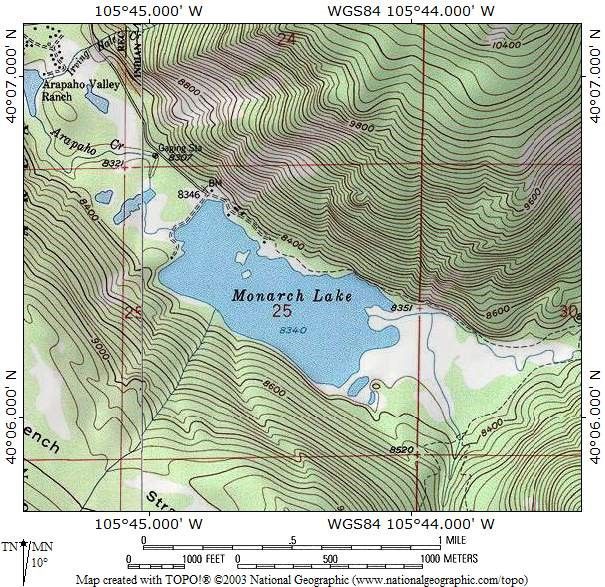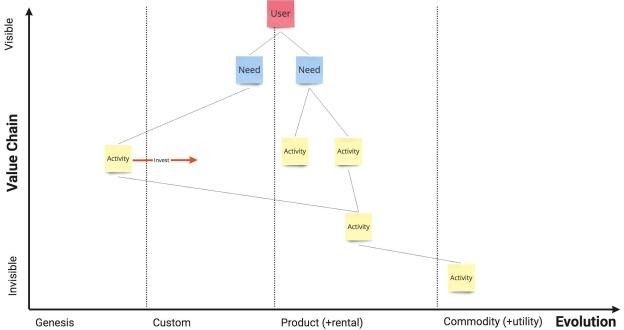Strategic plans that support intelligence are vital. Planning ahead and having advanced warning of possible shortcuts or obstacles helps individuals and organizations navigate uncertainty with steady footing. Although some plans may look good from the outside, not all plans are as equipped as others to support through to the end.
Take, for example, hikers climbing over a mountain. They are given two options to navigate the trails: a list of directions or a map. The directions details all the obstacles on the mountain, like how many rocks and trees are in an area, but it does not show exact locations.
The map, on the other hand, shows all the major mountain locations visually with distance but does not tell the hiker how many trees they will pass. Using a map, the hiker is able to:
- Avoid sheer drops
- Clearly know their location
- Pinpoint resources like running water
- Define which route will be shorter

Trail map, Monarch Lake, Colorado (Source)
Sure, a tree may fall on a path or a rockslide may occur, but if that hiker has planned their course using a map, they can now tackle the obstacles with more ease. Using mere directions, the hiker might have to try multiple times to reroute or find resources. The choice is clear: hikers use maps for a reason.
When we apply the simple use of strategic landscape mapping to business (or any operation), it is essentially the same concept. And that concept is called Wardley Value Chain Mapping.
In this article, we’ll:
Who is Simon Wardley?
A thought leader in business with decades of experience, Simon Wardley created mapping in 2005 to
- Predict market trends
- Foresee outcomes within his organization
Today, with a focus on corporate-level IT strategies, he helps business leaders build intuitive and shareable maps that deliver several advanced operational benefits.
At the Leading Edge Form (LEF), Wardley “uses mapping in his research for the LEF covering areas from Serverless to Nation-State competition whilst also advising/teaching LEF clients on mapping, strategy, organization, and leadership.”
What is Wardley Value Chain Mapping?
Wardley value chain mapping is a way for you to:
- Visualize and examine your environment
- Identify upcoming changes
- Properly choose actions and activities
“By examining what is needed, what components will be in use, what are their dependencies and characteristics, you can build a visual representation of your world, play what-if games, and pick your direction and best actions to support it.” –GitHub
Understanding that all organizations operate within a landscape is the core of Wardley Value Chain Mapping. In business, the landscape is expressed by the value chain or independent activities needed to reach user goals. These are then set into place based on evolution and demand. The end result is a visual graphic depicting risk predictions and objectives.
Used to avoid project risk, Value Chain Maps are continual. They have an infinite level of potential. As you identify each new insight, you’ll also reveal new decision outlets. Start small and don’t worry about getting the first map right. Improvements are part of the process.
Here’s Wardley in 2014:
Benefits of mapping
Benefits of Wardley Value Chain Mapping include:
- Advanced company-wide communication
- Enhanced risk and opportunity identification
- Advanced utility of products
- An easier ability to cut costs
- Advanced collaboration of teams at all levels
Strategic plans that support intelligence are essential to success. From the hiker to government leaders, CEOs, project managers—strategy is used to guide decision-making and avoiding getting lost. With that in mind, according to Simon in an article from Medium,
“Strategy is all about observing the landscape, understanding how it is changing, and using what resources you have to maximize your chances of success.”
It is like playing a game of chess and the board is a landscape map.
Wardley map example

(Source)
There are two layers to the map. Define the User, Need, and Activity to determine the X and Y axes. For example:
- Person → Need: Hunger → Activity: Acquire smoothie
- Smoothie company → Need: Ingredients → Need: Recipes → Activity: Blending smoothie
- Smoothie company → Need: Standardized recipes throughout stores → Activity: Printed menus
How to create a Wardley map
Follow these steps to understand, and then create, your own Wardley Value Chain map.
Step 1: Define your purpose & user needs
To begin a Wardley Map, identify a purpose or driving force. Determine:
- Why you’re doing the work
- What you hope to achieve
- What others will gain from the goal
Ultimately, the purpose should center around the user—the customer.
Step 2: Use value chains to define the scope
Next, focus on critical elements. As Wardley writes for CIO, “Once you’ve determined the high-level needs, the next step is to flesh this out with the components required to meet those needs.”
In this step, answer questions like:
- What does the user need?
- How do you serve this need?
- What adds to each component when fulfilling the need?
- Are there any dependencies or links?
The chains will go from a user (most valuable) to need, then to activity (least valuable).
Step 3: Link the value chains
In this step, you’ll create the value chain map. As an example of a chain, if a user wants to watch a batman show, they may subscribe to a cable provider, that cable provider hires a studio to make a superhero series, the studio hires writers to script the series with batman, and so on. This chain, as-is, isn’t too useful or productive.
Instead, to provide context to these value chains, you’ll want to apply “change over time”. Simon offers a tip for overcoming change plotting:
“Take your value chain and plot the components along an evolution axis covering genesis, custom-built, product (+rental), and commodity (+utility).”
Moving left to right in terms of supply and demand, you’ll build a map. It is the activities of the map that move into the genesis, custom, product, or commodity columns.
Step 4: Gap & similarity analysis
After completing your map, you can can use it on multiple levels to:
- Curb bias
- Enhance communication
- Eliminate duplicates
Comparing internal maps as well as competitor maps will reveal opportunities often overlooked or left unchallenged. As Simon describes:
“One of the beautiful things about maps is that you can start to build up a portfolio of maps from different parts of the organization and start to challenge this duplication and bias by sharing. Maps give you the communication mechanism to do this.”
Three pillars of Wardley mapping
- Visualize systems and how they change.
- Know the basic patterns of capitalism.
- Exploit patterns with strategic intent.
A tool for those who want to create and understand a clear strategy plan, Wardley Value Chain Mapping opens up awareness of risk and helps maximize the ability to use opportunities. Within business, staying ahead of the curve with clearly mapped strategy changes the game.
Before setting out on your own creating Wardley Maps, study previously proven maps.
Related reading
- BMC Business of IT Blog
- The VSEM (Vision, Strategy, Execution, and Metrics) Framework Explained
- Lewin’s 3 Stage Change Model
- What Is Goodhart’s Law? Balancing Measurement & Authenticity
- How to Create an IT Strategy: Getting Started







